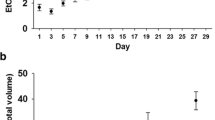Abstract
The functional consequences following methamphetamine-induced neuronal damage were evaluated under several different conditions known to affect the magnitude of the lesion. It was found that methamphetamine (6.25 mg/kg administered SC, four times at 2-h intervals) caused long-lasting depletions of striatal dopamine and serotonin and that pretreatment with the antioxidant, ascorbic acid (100 mg/kg), attenuated these depletions, whereas pretreatment with the superoxide dismutase inhibitor diethyldithiocarbamate (200 mg/kg) exacerbated these depletions. The dopamine depletions resulting from the repeated administration of methamphetamine under these various conditions did not result in any alteration in the consumption of a sweetened-condensed milk solution under baseline conditions. However, when these lesioned animals were challenged with acutely administered methamphetamine, it was observed that there was an altered sensitivity to the milk intake decreasing effects of this compound. That is, the degree to which the acutely administered methamphetamine reduced the intake of sweetened-condensed milk was highly correlated with the magnitude of the methamphetamine-induced dopamine and serotonin depletions. These observations support the hypothesis that methamphetamine-induced neuronal damage is mediated by free radical formation and indicate that behavioral measures may be employed to assess neuronal damage.
Similar content being viewed by others
References
Ando K, Johanson CE, Seiden LS, Schuster CR (1984) Sensitivity changes to dopamine agents in fine motor control of rhesus monkeys after repeated methamphetamine administration. Pharmacol Biochem Behav 22:737–743.
Bittner SE, Wagner GC, Aigner TG, Seiden LS (1981) Effects of a high dose treatment of methamphetamine on caudate dopamine and anorexia in rats. Pharmacol Biochem Behav 14:481–486.
Commins DE, Axt KJ, Vosmer G, Seiden LS (1987) 5,6-Dihydroxytryoptamine, a serotonergic neurotoxin, is formed endogenously in the rat brain. Brain Res 403:7–14.
Finnegan KT, Ricaurte GA, Seiden LS, Schuster CR (1980) Altered sensitivity to d-methamphetamine, apomorphine and haloperidol in rhesus monkeys depleted of caudate dopamine by repeated administration of d-methamphetamine. Psychopharmacology 77:43–52.
Hadjiconstatinou H, Neff NH (1983) Ascorbic acid could be hazardous to your experiments: a commentary on dopamine receptor binding studies with a speculation on a role for ascorbic acid in neuronal function. Neuropharmacology 22:939–943.
Kogan FJ, Nichols WK, Gibb JW (1976) Influence of methamphetamine on nigral and striatal tyrosine hydroxylase activity and on striaal dopamine levels. Eur J Pharmacol 36:363–371.
Lucot JB, Wagner GC, Schuster CR, Seiden LS (1980) Effects of dopaminergic agents on the locomotor activity of rats after high doses of methamphetamine. Pharmacol Biochem Behav 13:409–413.
Ricaurte GA, Guillery RW, Seiden LS, Schuster CR, Moore RY (1982) Dopamine nerve terminal degeneration produced by high doses of methamphetamine in the rat brain. Brain Res 235:93–103.
Seiden LS, Vosmer G (1984) Formation of 6-hydroxydopamine in caudate nucleus of the rat brain after a single large dose of methamphetamine. Pharmacol Biochem Behav 21:29–31.
Wagner GC, Seiden LS, Schuster CR (1979) Methamphetamine-induced changes in brain catecholamines in rats and guinea pigs. Drug Alcohol Depend 4:435–438.
Wagner GC, Ricaurte GA, Seiden LS, Schuster CR, Miller JM, Westly J (1980) Long-lasting depletion of striatal dopamine and loss of dopamine uptake sites following the repeated administration of methamphetamine. Brain Res 181:151–160.
Wagner GC, Gardner J, Tsigas J, Masters DB (1984) Tolerance following the repeated administration of high doses of phencyclidine: no relation to central catecholamine depletion. Drug Alcohol Depend 13:225–234.
Wagner GC, Carelli RM, Jarvis MJ (1985) Pretreatment with ascorbic acid attenuates the neurotoxic effects of methamphetamine in rats. Res Commun Chem Pathol Pharmacol 47:221–228.
Author information
Authors and Affiliations
Rights and permissions
About this article
Cite this article
De Vito, M.J., Wagner, G.C. Functional consequences following methamphetamine-induced neuronal damage. Psychopharmacology 97, 432–435 (1989). https://doi.org/10.1007/BF00439543
Received:
Accepted:
Issue Date:
DOI: https://doi.org/10.1007/BF00439543




